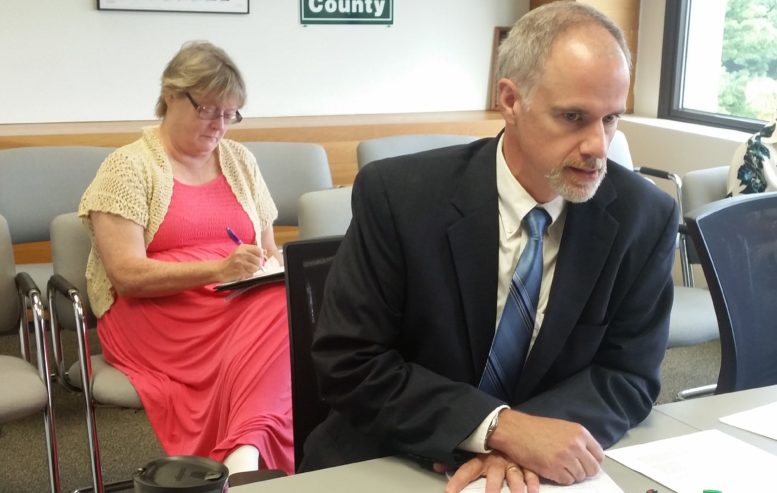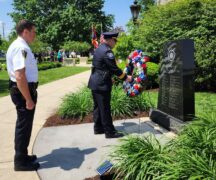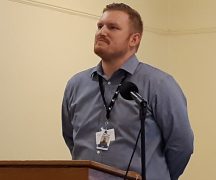By JAN LARSON McLAUGHLIN
BG Independent News
The horror of the opiate epidemic is not some distant tragedy for Wood County Prosecuting Attorney Paul Dobson.
“Last year, 14 months ago, I lost my stepson to this crap – opiates,” he said Tuesday to the Wood County Commissioners.
His stepson, who was 37 when he died of an overdose in Colorado last year, had struggled with opiates, recovered, then relapsed. As part of treatment, he went through an Ohio Means Jobs program in Toledo, which gave him an opportunity to go to University of Toledo, where he earned certification. The program gave him gas cards, a lap top computer and helped with car repairs.
“They were taking away every excuse to fail,” Dobson said.
But eventually, his stepson – who moved to Denver for a job – overdosed and died. “He couldn’t let the ‘dragon’ go,” Dobson said.
Though his stepson was ultimately not helped with intense programming, Dobson is hoping that others will be.
“There’s always hope. My faith doesn’t allow for me to not have hope,” he said.
According to the Wood County Coroner’s Office, 16 people died of opiate overdoses in the county last year. In response to a survey of local first responders, 16 departments said they responded to 83 opiate overdoses last year, and administered the life-saving drug Naloxone 60 times. And in the last 18 months, the county prosecutor’s office has seen about 130 drug cases.
Dobson presented this hopes to the county commissioners Tuesday in the form of a four-tiered plan for dealing with the opiate epidemic in Wood County. The plan calls for the creation of a quick response team, a pre-trial diversion program in the prosecutor’s office, an intervention in lieu of sentencing program in the courts, and the establishment of a drug docket in the courts.
But in order to put this program in motion, Dobson first needs a grant from the Ohio Attorney General’s Office for $150,000 over two years. And in order to get that grant, he first had to convince the county commissioners to agree that they will foot the bill after the grant funding runs out if the program proves to be successful.
Lucas County already has its DART (Drug Abuse Response Team) program in place. That program provides immediate responses to calls about opiate drug abuse. “At 2 o’clock in the morning, they have somebody ready to head out” to a home, hospital or hotel to try to get the addict hooked up the treatment, Dobson said.
Wood County’s program will be different, he explained. The program will set up a quick response team that will respond within 24 hours of getting a call from families, first responders or hospitals that an addict needs help.
“There’s no way we can fund having people on staff 24 hours,” he said.
If the grant is approved, the sheriff’s office has agreed to assign one full-time deputy to Dobson’s office. That deputy will focus solely on responding to reports of opiate abuse.
The program will need a second staff member – a drug addiction and response coordinator. That person will talk with the deputy and line up services the addict needs – such as an evaluation, bed in a treatment center, or help from Job and Family Services. The coordinator would also help keep track of the person’s progress.
“While getting them into treatment is essential,” Dobson said, keeping them in and getting them back after relapses are also important. The average person experiences seven relapses during their three to five years of trying to get free of opiates.
Dobson’s four-tiered program includes:
- Quick response team.
- Prosecutor’s pre-trial diversion program, which allows his office to address drug addictions. If the person completes the program, “then the case will be dismissed,” he said. However, Dobson pointed out that some offenses may not qualify. “I’m not going to take someone who has broken into somebody’s house. We need to continue to protect the public.”
- Intervention in lieu of sentencing program, in which the addict agrees to plead guilty in exchange for being placed in a treatment program. If the program is completed, the charges are dropped. If the person fails, they proceed directly to sentencing. The program coordinator would keep track if the efforts are helping to reduce drug abuse, relapses and overdose deaths.
- Drug docket for court, which would connect the courts and treatment providers to find out how the person is progressing.
Dobson said his four-tiered plan has support from several different agencies in the county, including every police department, the state patrol, sheriff’s office, BGSU, Wood County Alcohol Drug Abuse and Mental Health Services, the Islamic Center, Cedar Creek Church, Catholic Diocese, A Renewed Mind, Falcon Health Center and both municipal courts.
“I’ve been talking with every person who will listen,” he said. “I’ve got over 40 letters of support from people who are saying this is a great idea.”
Dobson said, as far as he is aware, he is the only prosecuting attorney in the state seeking the grant funding. Ohio is the top state in the nation currently for opiate deaths.
Dobson told the commissioners he needed their support by Friday, when he has to submit the grant request to the state. He is asking for the commissioners to pick up the costs of the sheriff deputy, which is estimated with benefits at $77,000, and for the coordinator whose annual pay would be between $49,000 and $59,000, once the grant funding ends.
Commissioner Doris Herringshaw said Dobson would have their answer by Thursday. Commissioner Ted Bowlus told Dobson that the four-tiered plan is “ingenious.” Commissioner Craig LaHote was absent.
If the grant is received, the program can be functional by Oct. 1, Dobson said.





